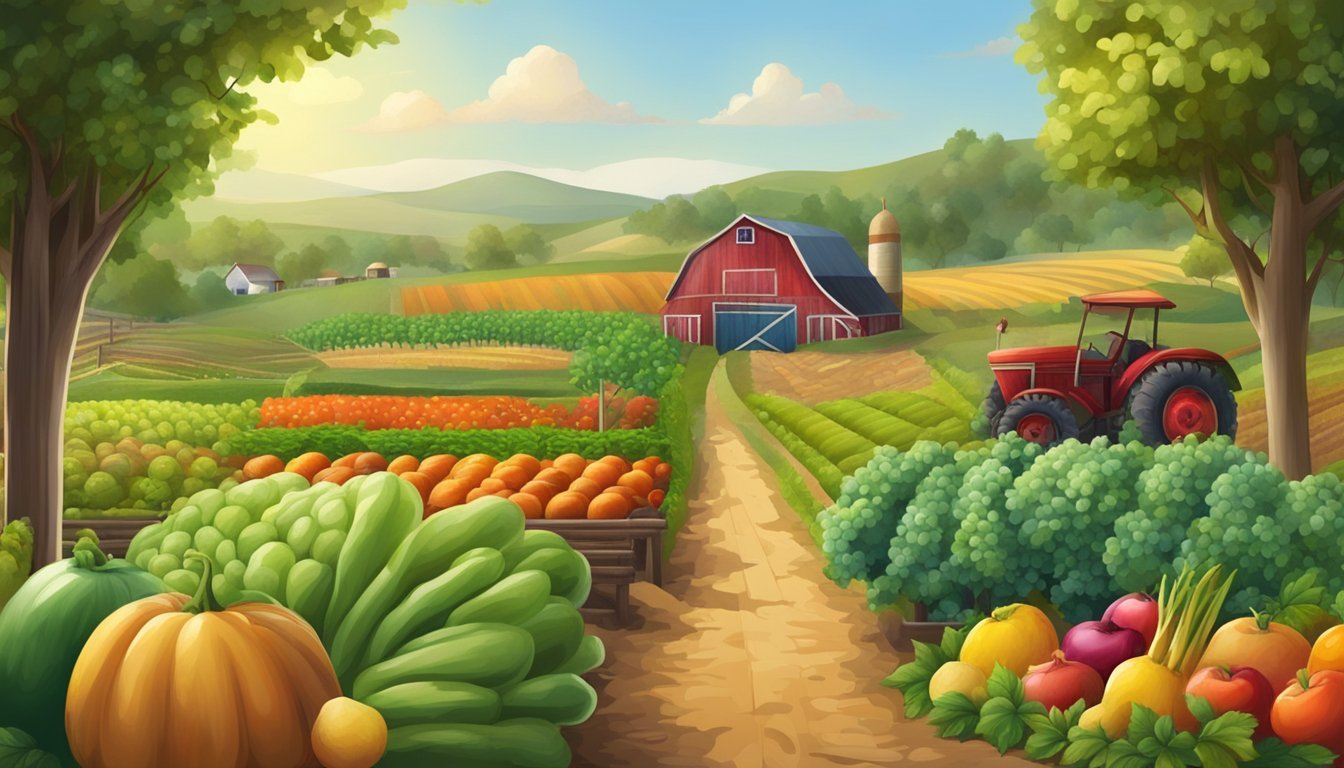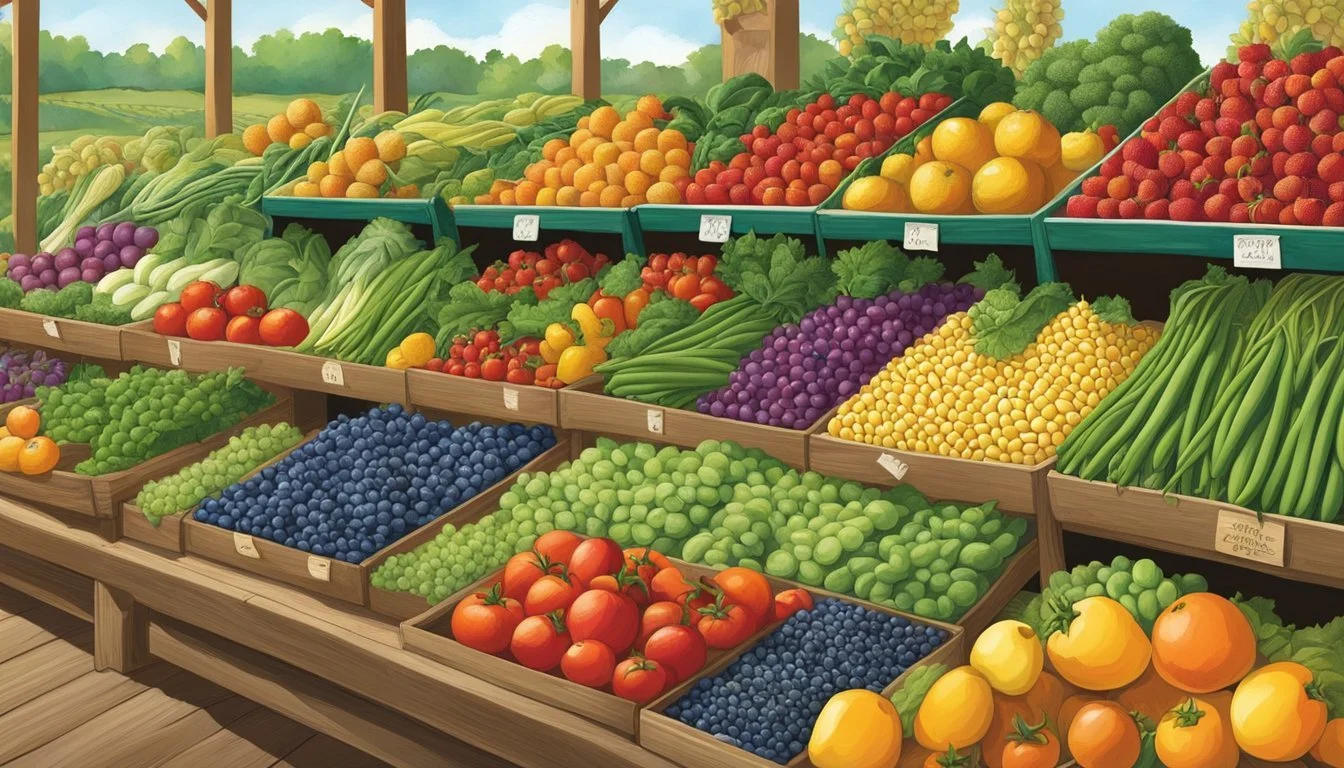Indiana Seasonal Fruit & Veg Guide
Your Ultimate Year-Round Companion
Indiana's temperate climate, marked by distinct seasons, lays the foundation for a rich variety of fruits and vegetables that rotate with the changing months. The state's local farms and agricultural practices are tuned to the rhythm of the seasons, offering consumers a farm-to-table experience that not only supports the local economy but also provides fresh, nutritious, and flavorful produce. From the sweet summer burst of berries to the autumnal harvest of pumpkins and apples, Indiana's seasonal produce is a testament to the state's diverse and bountiful growing conditions.
Embracing the farm-to-table movement involves understanding the seasonal availability of produce to make sustainable and health-conscious choices. Indiana residents and chefs alike benefit from a guide that not only outlines when their favorite produce will be at its peak but also suggests the appropriate time to look for the freshest local ingredients. By syncing with nature's timetable, Hoosiers can indulge in the freshest tomatoes during the balmy summers or savor the hearty squashes as the chill of fall sets in, thus elevating the culinary experience with ingredients meant to be enjoyed in their prime.
Navigating through Indiana's seasonal offerings encourages a closer connection to the local environment and its agricultural roots. This approach not only guarantees the freshest flavors but also minimizes the carbon footprint associated with long-distance transportation of out-of-season produce. For those looking to enrich their diet and support sustainability, a comprehensive guide to Indiana's seasonal fruits and vegetables becomes an indispensable tool.
What’s in Season in Indiana Right Now?
Seasonal Overview of Indiana Produce
Indiana's diverse climate allows for a variety of fruits and vegetables to be grown and harvested during specific seasons. Each brings a bounty of specific produce, aligned with the state's agricultural calendar.
Spring Harvest
In Indiana, spring brings a fresh start to local agriculture, beginning as early as April. Asparagus (how long does asparagus last?), lettuce, rhubarb, and chard are among the first crops to sprout, offering crisp and fresh flavors. Herbs start to flourish, along with peas and radishes, which are typically ready by late spring.
Summer Abundance
As the days lengthen from June through August, Indiana's fields are in full swing. Berries such as strawberries, blueberries, and raspberries hit their peak, while peaches add sweet juiciness to the summer yield. Tomatoes, cucumbers (how long do cucumbers last?), and a variety of peppers thrive in the heat. Sweet corn and green beans emerge, as well as summer favorites like zucchini, squash, and beans. Melons, including watermelon and cantaloupe (how long does cantaloupe last?), become prime for picking during the warmest months.
Fall Harvest Season
The arrival of September and October signals the onset of fall and the impending close of the harvest season. Indiana orchards yield a variety of apples and an ample supply of pears and plums. Fields are adorned with pumpkins and different types of winter squash. Fall crops like sweet corn, additional peppers, cabbage, and kale can still be found during these months, bridging the seasonal transition from summer's end to the beginning of cooler days.
Indiana's Farm to Table Network
Indiana's Farm to Table Network connects consumers directly with the source of their food, ensuring fresh, locally-grown crops. Through farmers markets, Community Supported Agriculture (CSA), farms, and sustainable practices, Indiana promotes the movement state-wide.
Local Farmers Markets
In towns across Indiana, farmers markets serve as crucial hubs for farm to table produce. These markets feature a variety of seasonal fruits and vegetables sourced directly from local farms. The availability of produce follows a schedule with staples like strawberries appearing in early summer and apples in the fall. Maps often guide consumers to the nearest farmers market, ensuring that the state's agricultural bounty is accessible to all.
Fort Wayne, IN: Junk Ditch Brewing Company
Danville, IN: Beasley's Orchard & Gardens
Shipshewana, IN: Blue Gate Restaurant
Community Supported Agriculture
Community Supported Agriculture programs in Indiana allow individuals to subscribe and receive a portion of a farm's harvest regularly. It's a method that supports local farmers financially and provides participants with a diverse array of farm fresh produce.
Common CSA offerings: Vegetables, fruits, eggs, and meat
Benefits: Freshness, support for local agriculture, and exposure to new produce varieties
Indiana Farms and Orchards
Farms and orchards throughout Indiana are vital components of the farm to table movement. They provide residents with the chance to purchase produce directly on-site and often engage in agritourism activities such as u-pick events.
Orchards: Offer apple picking, berry harvesting
Farms: May host events, educational tours, and tastings
Sustainable Farming Practices
Sustainability underpins Indiana's Farm to Table Network. Farmers across the state integrate practices like crop rotation, organic farming, and using natural fertilizers to maintain soil health and reduce their environmental impact. Sustainable farming contributes to the longevity and productivity of Indiana's agricultural landscape.
Techniques used: Crop rotation, composting, integrated pest management
Outcome: Enhanced soil fertility, reduced chemical use, improved ecosystem health
Monthly Guide to Indiana Produce
When traversing through the rich agricultural tapestry of Indiana, one discovers a diverse palette of produce that cycles with the seasons. This section will take you through a selection of Indiana's freshest offerings, ensuring you can savor the peak flavors each month provides.
What to Buy and Eat in April
In the cool, yet budding month of April, expect to fill your basket with:
Asparagus: Tender and perfect for roasting or grilling.
Lettuce: Crisp varieties abound, from romaine to butterhead.
Chard: A leafy green, versatile for salads and sautéing.
Herbs: Such as chives (how long do chives last?) and parsley, adding fresh bursts of flavor.
Peas: Garden peas and sugar snaps, sweet and crisp.
Radishes: Red and spicy, ideal for salads and garnishes.
Indiana's Fresh Choices in July
By July, the sun blesses the soil and you can indulge in summer's abundance:
Tomatoes: Juicy and vine-ripened, a staple in salads and sandwiches.
Cucumbers: Cool and refreshing, perfect for fresh salads.
Corn: Sweet corn is at its peak, ready for the grill or to be enjoyed on the cob.
Peppers: From sweet bell to fiery chili varieties.
Zucchini & Squash: Ideal for grilling or as a feature in quick breads.
Beans: Snap beans, rich in flavor and perfect for a variety of dishes.
Melons: Including cantaloupe and watermelon, juicy and hydrating.
Raspberries: Fragrant and sweet, excellent for desserts or as a fresh snack.
Green Beans: Crisp and tender, ready for steaming or sautéing.
Herbs: Basil, mint, and more to enhance any summer dish.
Seasonal Picks for October
As the leaves change, the harvest brings forth the warmth of fall flavors:
Apples: From tart to sweet, for baking or snacking.
Pears: Ripe and juicy, they complement both sweet and savory plates.
Plums: Perfectly plump, ready for jams or desserts.
Pumpkins: A fall favorite for pies and decor.
Winter Squash: Butternut, acorn, and others, each with rich, sweet flesh.
Sweet Corn: End of season corn that still captures the essence of summer.
Peppers: Late harvest varieties still available.
Kale: Hardy and nutritious, great for soups and salads.
Indulging in Indiana's seasonal produce not only supports local farmers but also ensures the most flavorful experience for your palate.
Preservation and Preparation Tips
Preserving the bounty of Indiana's seasonal fruits and vegetables is crucial for enjoying the local flavors year-round. Proper handling and storage methods can ensure peak freshness and taste.
Canning and Pickling Indiana Produce
For tomatoes, cucumbers, and peppers, canning and pickling are excellent preservation methods. To can tomatoes, first dip them in boiling water for about 30 seconds to loosen the skin, then peel, core, and quarter them before placing them in jars. Vegetables like cucumbers and peppers are also great for pickling. For pickling, they should be cut uniformly and placed in a solution of vinegar, water, salt, and optionally, sugar.
Strawberries: Prepare a light syrup from sugar and water, pack strawberries into jars, and cover with syrup before sealing.
Peaches: Peel, pit, and slice. To prevent browning, soak slices in a mixture of ascorbic acid and water before canning.
Corn: Blanch corn on the cob for 4 minutes, cool in ice water, cut off the kernels, and pack into jars with a pinch of salt.
Apples: Can be canned as apple sauce or slices. To prevent browning, soak in a lemon juice and water solution.
Freezing and Storing Tips
Freezing provides an easy way to preserve the flavors of Indiana’s fruits and vegetables. Before freezing fruits like blueberries and strawberries, one should wash, thoroughly dry, and spread them out in a single layer on a baking sheet to freeze initially. Once frozen, transfer them into airtight containers or freezer bags.
Vegetables require blanching before freezing:
Corn: Blanch ears for 7-10 minutes, cool them in ice water, then cut kernels from the cob before freezing.
Squash and peppers: Slice, blanch for 2-3 minutes, perform a quick cold bath, drain, and freeze.
Tomatoes: Can be frozen whole or in pieces on a baking sheet, and then transferred to freezer bags.
Apples can be peeled, cored, sliced, and treated with ascorbic acid to prevent browning before freezing. For items like peaches, slice and treat with ascorbic acid or lemon juice to avoid discoloration, then freeze in a single layer before storing in bags or containers.
Understanding Seasonal Availability
In Indiana, the availability of fresh fruits and vegetables is closely tied to the seasonal cycle. Such patterns dictate when produce reaches peak ripeness and is harvested for market, impacting not only the flavor but also the environmental benefits and economic considerations for local farms.
Benefits of Seasonal Eating
Eating seasonally in Indiana brings a plethora of advantages. Health benefits are prominent, as vegetables and fruits harvested at their peak tend to have higher nutritional value. Additionally, seasonal eating tends to be more environmentally friendly. It encourages consuming local produce, which means reduced transportation emissions and support for local farms. This practice also aligns with the natural harvest cycles, ensuring that plants are grown under optimal conditions and are less reliant on artificial means of production.
How Weather Affects Crop Yield
Weather plays a significant role in the success of crop yields in Indiana. Unpredictable Midwestern climate conditions, including temperature swings and precipitation variances, can either bolster or hinder plant growth. The availability of certain crops during their expected seasons can change rapidly in response to these weather fluctuations. Farms must continually adapt to these changes to maintain the health and productivity of their plants. Understanding these patterns helps in predicting the best times for planting and harvesting, thus maximizing yield and quality.







